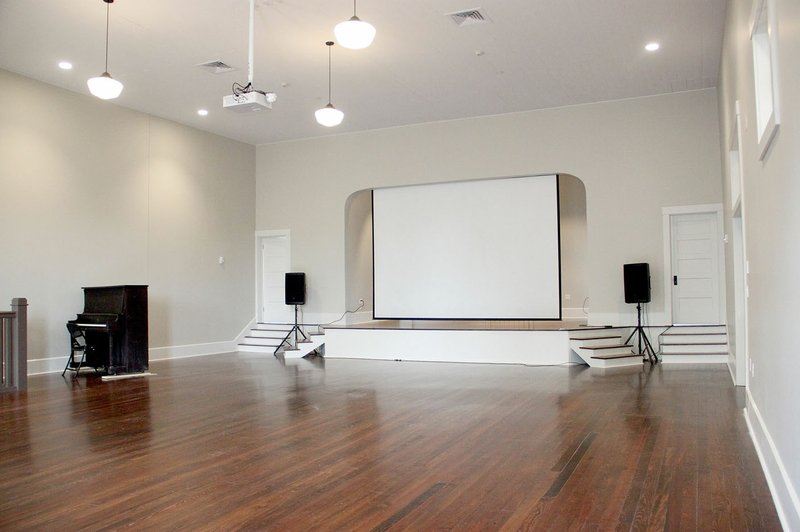CANE HILL -- The public is invited Saturday to celebrate the culmination of a 2 1/2-year project to restore the Cane Hill College building, located off state Highway 45 in the small, historic community of Cane Hill.
The 4,000-square-foot building is listed on the National Register of Historic Places and stands as a reminder that education has always been important to the Cane Hill area.
Historic Cane Hill College Celebration and Grand Opening will begin at 11 a.m., Saturday, May 13. A ribbon cutting will be held at noon. Festivities during the day will be free food and drinks, music, a horseshoe tournament and tours of Cane Hill College and other historic buildings in the community.
Tom Pennel, events coordinator, encouraged people to come out to the grand opening.
"Everything is free," Pennel said. "We'll have prizes for the horseshoe tournament and checkers and chess sets will be out for people to sit down and play a few games."
He said activities will probably continue throughout the afternoon.
The current two-story, brick College building was constructed in 1886 and everything in the building has been restored as part of a $1.4 million project by Historic Cane Hill Inc., a non-profit organization established in 2013 dedicated to the preservation of historic buildings and property in the area.
Bobby Braly, executive director, said the brick exterior of the building is a 1880s look while the inside will retain what the building looked like in the 1930s.
Work was completed in three phases. The first phase stabilized the structure by reinforcing the foundation with helical piers that were drilled down to bedrock.
Phase two included restoring the exterior of the Italianate-style building. Windows were replaced by tall, narrow, triple-hung windows to match the original structure, walls were repaired and in some places completely replaced and a wood shingle roof was added.
Views from the windows show open grassy areas, Cane Hill College grounds and large, beautiful, old trees.
Phase three was interior work.
Visitors will see the original, restored wood floors on the inside of the building. Walls have been painted a historically correct color.
Modern conveniences include a real kitchen with upscale appliances that will make it easier for groups to use Cane Hill College for a multitude of events, including banquets, rehearsal dinners, reunions and other community activities.
The upstairs has two large open rooms, including an auditorium with new audio and video equipment and a 12-foot screen to accommodate programs that need new technology.
The room that once housed Cane Hill College Museum has the original light fixtures installed when electricity came to Cane Hill. These same lights are replicated throughout the rest of the building.
Braly said he is interested to see how the public will use the building in the future. He said possibilities include weddings, recitals, movie nights and of course, activities with the annual Cane Hill Harvest Festival.
Historic Cane Hill has been busy the past several years restoring other historic buildings in Cane Hill but the College has always been the main project, Braly said.
"The College is our cornerstone project. It is the most important building to save," he said, noting the College is what links the community to its focus on education.
Cane Hill was the earliest white settlement in Washington County and was designated Cane Hill Township in 1829.
The first school, called Cane Hill School, was started by the Cane Hill congregation of the Cumberland Presbyterian Church in 1835. It was the first formally organized school in Northwest Arkansas and was located about three miles north of the Cane Hill Post Office.
In 1850, Cane Hill School relocated to Boonsboro (which later becomes Canehill) and was chartered as Cane Hill Collegiate Institute. The Institute occupied a two room, brick house. In 1852, the Arkansas General Assembly granted a charter to Cane Hill College. The college could grant four-year college degrees, making it one of the first four-year colleges in Arkansas.
Additional buildings were constructed and a fourth building located south of the campus was used for housing. The Civil War ensued and the College closed its doors during the conflict.
In 1864, Union troops burned many of the buildings at Cane Hill, including the three College's three main structures but not the dormitory.
Cane Hill College reopened in 1865 in the dormitory building and built a new wood-frame building in 1868. This classroom building was destroyed by fire in 1885, supposedly by a moonshiner who was angry because he had been run out of town by the church.
The Cane Hill College Board decided to rebuild and completed a two-story, brick building in December 1885. This is the present Cane Hill College building.
By this time, the Arkansas Industrial University had been established in Fayetteville and offered classes that competed with Cane Hill College. The College was not able to regain its pre-war prestige and closed in 1891. Its charter was taken to Clarksville when the Cumberland Presbyterian Church opened Arkansas Cumberland College in a more central location. Today, this school is the University of the Ozarks.
The Cane Hill College Building was later used as a public school for grades 1-12. The building was remodeled over the years with new windows and door openings and changes on the inside to create new classrooms. The last high school graduation from the Cane Hill Consolidated School took place in spring 1949, and grades 7-12 were transferred to Lincoln. Grades 1-6 transferred to Lincoln in December 1956.
The building has deteriorated over the years and in September 2013, the Cane Hill College Board of Directors voted to dissolve so that a new, non-profit organization called Historic Cane Hill Inc., could take over restoration of the building and other historic places in Cane Hill.
Historical information about Cane Hill College comes from Bobby Braly and a document written by Rachel Silva, who formerly was with Arkansas Historic Preservation Program.
General News on 05/10/2017
